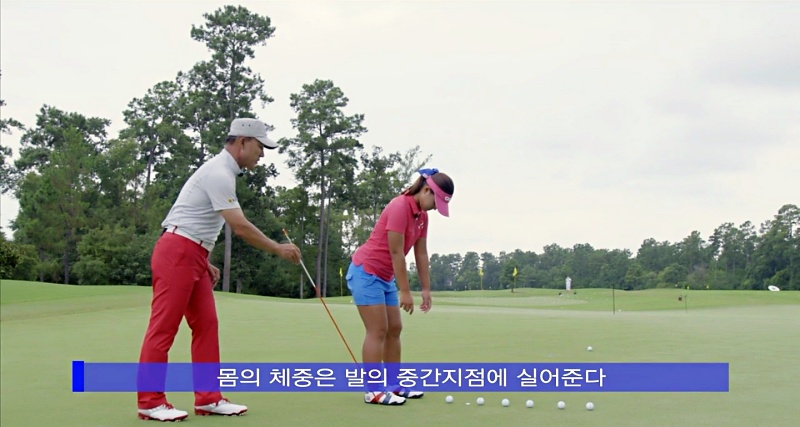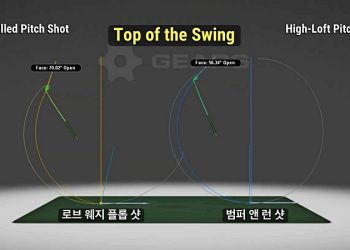골프는 정교함을 필요로 한다. 이를 위해서는 어드레스 자세부터 순서 있게 진행할 필요가 있다.
퍼팅 시 스탠스는 일반 스윙보다 좁다. 발은 어깨 너비가 아닌 엉덩이 너비로 벌린다. 상체가 상대적으로 가볍게 움직이게 하기 위해서다. 체중도 균등하게 놓이게 한다.
눈은 볼 바로 위나 약간 안쪽에 위치해야 한다. 그래야 방향의 착시 효과를 줄일 수 있다. 몸의 모든 부분 정렬도 목표 방향과 평행해야 방향을 섬세하게 지킬 수 있다. 측면에서 보면 엉덩이를 약간 뒤로 빼서 상체를 볼 쪽으로 기울인 모습이다. 이는 어깨를 부드럽게 하는 이상적인 시계추 모습이다.

퍼팅 시 그립도 스윙 때와는 차이가 있다. 손목의 회전을 없게 하면서 안정감을 갖기 위한 그립을 갖는다. 손가락 위주가 아닌 손바닥을 그립에 많이 닿게 하는 자세가 좋다. 팔꿈치만 약간 구부려도 어깨의 긴장을 줄일 수 있고 중요한 순간에 실수를 줄일 수 있다. 좀 더 안정감을 갖기 위한 삼각형 모양을 유지할 필요가 있다.
일반 스윙에서는 클럽 패스와 페이스 각의 차이를 두지만, 퍼팅에서는 퍼터 페이스를 목표선에 직각으로 정렬시키고 클럽 패스도 임팩트 순간에 같은 각도가 되도록 한다. 즉, 임팩트 시 퍼터 페이스가 목표선에 직각을 유지하면 퍼팅 성공률이 높아진다. 이상의 내용만 잘 따라 해도 정확한 퍼팅 스트로크를 만들 수 있다. 그리고 어드레스 자세만 반복적으로 만들어 봐도 도움이 된다.
정확성을 높이기 위한 퍼팅의 몇 가지 좋은 방법이 있다. 첫째, 일관된 템포 유지가 기본이 되어야 한다. 메트로놈을 이용하면 백스윙과 다운스윙의 리듬을 섬세하게 느낄 수 있다. 이러한 템포 연습은 집중력을 가지고 반복하면 몸으로 느낌을 얻을 수 있다.
둘째, 방향을 지키기 위해서 손목의 역할도 중요하다. 프로들은 퍼팅 스트로크 동안 손목 움직임 범위를 아주 최소화시킨다. 이게 클럽 페이스의 일관성을 높이는 중요한 팁이다.
셋째, 매 순간 퍼팅의 정렬을 확인할 필요가 있다. 어드레스를 취하고 퍼터 헤드만 움직일 정도로 양 끝에 티를 꽂는다. 티 사이로 퍼팅한다. 이는 경기 전에 손쉽게 할 수 있는 방법이며 짧은 순간에 집중력을 갖게 해 준다. 연습 시에 퍼터 힐 쪽 티에 맞으면 풀 샷, 토우 쪽 티에 맞으면 푸시 샷이 된다.
매 순간 그립을 같은 방법으로 잡는 연습을 하면 방향의 일관성이 좋아진다는 것도 기억해두면 좋다. 매번 같은 방식을 100번 이상씩 반복하면 실수를 확실히 줄일 수 있다. 또 중앙에 볼을 맞히는 연습도 반복할 필요가 있다. 퍼터 페이스면의 중앙은 방향성을 높이는 데 절대적이다. 믿을 수 있는 런치 모니터를 활용하면 통계 자료를 모을 수 있다. 기본적인 퍼팅 자세를 잘 지켜야 응용 동작에서 거리와 방향을 만들어 낼 수 있다.
퍼팅에선 방향보다는 최적의 스피드가 우선이 되어야 한다. 상상력을 발휘해서 볼의 흐름을 눈으로 그려볼 필요가 있다. 공의 경로를 시각화해 보는 것이다.
그린 위에서 짧은 시간에 모든 것을 진행하는 것도 훈련이다. 훈련이 되어야 그린의 빠르기에 상관없이 성공률을 높일 수 있다. 경사도가 클수록 볼의 반대 방향에서 볼이 굴러오는 흐름에 많은 훈련을 해야 섬세한 성공을 유지할 수 있다.
결론적으로 퍼팅은 반복적인 훈련이 가장 중요하다. 그러기 위해선 매일 짧은 시간이라도 집중해서 연습하는 습관을 지녀야 한다. 성공한 프로들은 늘 성실한 훈련을 통해 만들어진다는 사실을 기억할 필요가 있다.
☞ 전욱휴는…
서울대 졸업 후 미국에 유학, 1996년 PGA 클래스A 프로가 됐다. 이후 28년만인 2024년 전세계 골프계 최고 권위의 ‘PGA 마스터 프로페셔널’ 자격을 획득했다. SBS, MBC, JTBC, YTN 등의 골프 채널 진행자 및 해설자로 활약했고, 지금은 애틀랜타와 한국을 오가며 골프 레슨 및 골프 관련 비즈니스를 하고 있다. chungolf@gmail.com
[Dr Eric Chun’s Golf Lesson] 36. The Secret to Successful Putting for Weekend Golfers
The key to success lies in two fundamental principles: adhering to the basics and engaging in consistent, daily practice.
Golf demands precision, and to achieve this precision, it is essential to proceed methodically, starting with the address position.
When putting, one adopts a narrower stance compared to a regular swing. The feet are positioned hip-width apart rather than shoulder-width, allowing for a relatively lighter upper body movement. Weight distribution should be even.
The eyes should be positioned directly above or slightly inside the ball to reduce directional optical illusions. All body parts must be aligned parallel to the target line to maintain directional accuracy. From a side view, the hips are slightly pushed back, tilting the upper body towards the ball. This creates a smooth shoulder movement and an ideal pendulum motion.
The putting grip differs from the regular swing grip. It aims to eliminate wrist rotation while maintaining stability. A palm-dominant grip is preferable to a finger-dominant one. Slightly bending the elbows can reduce shoulder tension and minimize errors at crucial moments. Maintaining a triangular shape can provide additional stability.
Unlike regular swings where club path and face angle differ, in putting, the putter face should be square to the target line, with the club path matching this angle at impact. Maintaining a square putter face to the target line at impact increases putting success rate. Adhering to these principles can help develop an accurate putting stroke. Repeatedly practicing the address position alone can be beneficial.
There are several effective methods to enhance putting accuracy:
Maintaining a consistent tempo is fundamental. Using a metronome can help develop a refined rhythm for the backswing and downswing. With focus and repetition, this tempo practice can become intuitive. Wrist control plays a crucial role in maintaining direction. During the putting stroke, professionals minimize wrist movement, which is key to maintaining club face consistency.
It’s necessary to check putting alignment constantly. Place tees at both ends of the putter head when addressing the ball, then putt between them. This is an easy pre-game practice that enhances focus. During practice, hitting the heel-side tee indicates a pull, while hitting the toe-side tee indicates a push.
Consistently gripping the club in the same manner improves directional consistency. Repeating the same grip method over 100 times can significantly reduce errors. Practicing center-face contact is also crucial, as the center of the putter face is critical for directional accuracy. Utilizing a reliable launch monitor can provide statistical data.
In putting, optimal speed takes precedence over direction. Visualize the ball’s path and imagine its roll. Practicing quick decision-making on the green is also part of training. This preparation allows for success regardless of green speed. Steeper slopes require more practice with ball movement from the opposite direction to maintain precise success.
Putting requires repetitive practice. More importantly, developing a habit of focused practice, even for short periods daily, is crucial. Remember that successful professionals are made through consistent, diligent practice routines.




![[전욱휴의 골프 레슨] 36. 퍼팅 성공 비결](https://www.atlantajoongang.com/wp-content/uploads/2024/12/ZzKakaoTalk_20241205_062313467_01-750x400.jpg)

















![[전욱휴의 골프 레슨] 46. 배치기(얼리 익스텐션)](https://www.atlantajoongang.com/wp-content/uploads/2025/03/photoKakaoTalk_20250306_073237889_01-350x250.jpg?v=1741361116)
![[전욱휴의 골프 레슨] 45. 임성재 '행온페이드' 샷](https://www.atlantajoongang.com/wp-content/uploads/2025/02/collage1-350x250.jpg)
![[전욱휴의 골프레슨] 44. 일관된 샷을 원한다면](https://www.atlantajoongang.com/wp-content/uploads/2025/02/QKakaoTalk_20250212_065748485-350x250.jpg)

![[전욱휴 골프 레슨] 42. 오른쪽 팔꿈치 역할](https://www.atlantajoongang.com/wp-content/uploads/2025/01/qQ1KakaoTalk_20250130_072058648-350x250.jpg)
![[전욱휴의 골프 레슨] 41. 매킬로이 파워 스윙](https://www.atlantajoongang.com/wp-content/uploads/2025/01/qQ1KakaoTalk_20250122_123635940-350x250.jpg)
